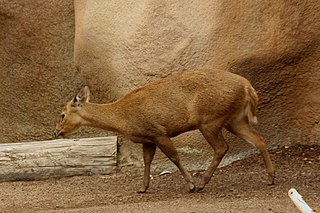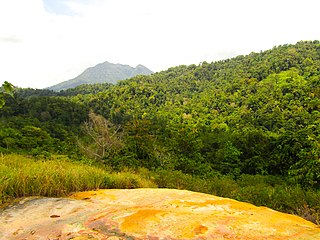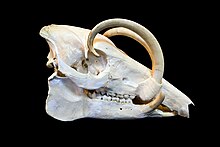
Artiodactyls are mammals belonging to the order Artiodactyla. Typically, they are ungulates which bear weight equally on two of their five toes: the third and fourth, often in the form of a hoof. The other three toes are either present, absent, vestigial, or pointing posteriorly. By contrast, odd-toed ungulates bear weight on an odd number of the five toes. Another difference between the two is that many even-toed ungulates digest plant cellulose in one or more stomach chambers rather than in their intestine as the odd-toed ungulates do. The advent of molecular biology, along with new fossil discoveries, found that cetaceans fall within this taxonomic branch, being most closely related to hippopotamuses. Some modern taxonomists thus apply the name Cetartiodactyla to this group, while others opt to include cetaceans within the existing name of Artiodactyla. Some researchers use "even-toed ungulates" to exclude cetaceans and only include terrestrial artiodactyls, making the term paraphyletic in nature.

The common warthog is a wild member of the pig family (Suidae) found in grassland, savanna, and woodland in sub-Saharan Africa. In the past, it was commonly treated as a subspecies of P. aethiopicus, but today that scientific name is restricted to the desert warthog of northern Kenya, Somalia, and eastern Ethiopia.

Tusks are elongated, continuously growing front teeth that protrude well beyond the mouth of certain mammal species. They are most commonly canine teeth, as with narwhals, musk deer, water deer, muntjac, pigs, hippopotamuses and walruses, or, in the case of elephants, elongated incisors. Tusks share common features such as extra-oral position, growth pattern, composition and structure, and lack of contribution to ingestion. Tusks are thought to have adapted to the extra-oral environments, like dry or aquatic or arctic. In most tusked species both the males and the females have tusks although the males' are larger. Most mammals with tusks have a pair of them growing out from either side of the mouth. Tusks are generally curved and have a smooth, continuous surface. The male narwhal's straight single helical tusk, which usually grows out from the left of the mouth, is an exception to the typical features of tusks described above. Continuous growth of tusks is enabled by formative tissues in the apical openings of the roots of the teeth. Prior to over hunting and proliferation of the ivory trade, elephant tusks weighing over 90 kg (200 lb) were not uncommon, though it is rare today to see any over 45 kg (100 lb).

Suidae is a family of artiodactyl mammals which are commonly called pigs, hogs or swine. In addition to numerous fossil species, 18 extant species are currently recognized, classified into between four and eight genera. Within this family, the genus Sus includes the domestic pig, Sus scrofa domesticus or Sus domesticus, and many species of wild pig from Europe to the Pacific. Other genera include babirusas and warthogs. All suids, or swine, are native to the Old World, ranging from Asia to Europe and Africa.

The water deer is a small deer species native to Korea and China. Its prominent tusks, similar to those of musk deer, have led to both subspecies being colloquially named vampire deer in English-speaking areas to which they have been imported. It was first described to the Western world by Robert Swinhoe in 1870.

The tufted deer is a small species of deer characterized by a prominent tuft of black hair on its forehead and fang-like canines for the males. It is a close relative of the muntjac, living somewhat further north over a wide area of central China and northeastern Myanmar. Suffering from overhunting and habitat loss, this deer is considered near-threatened. It is the only member of the genus Elaphodus.

The babirusas, also called deer-pigs, are a genus, Babyrousa, in the swine family found in the Indonesian islands of Sulawesi, Togian, Sula and Buru. All members of this genus were considered part of a single species until 2002, the babirusa, B. babyrussa, but following that was split into several species. This scientific name is restricted to the Buru babirusa from Buru and Sula, whereas the best-known species, the north Sulawesi babirusa, is named B. celebensis. The remarkable "prehistoric" appearance of these mammals is largely due to the prominent upwards incurving canine tusks of the males, which actually pierce the flesh in the snout.

The red river hog or bushpig, is a wild member of the pig family living in Africa, with most of its distribution in the Guinean and Congolian forests. It is rarely seen away from rainforests, and generally prefers areas near rivers or swamps.

The Calamian deer, also known as Calamian hog deer, is an endangered species of deer found only in the Calamian Islands of Palawan province in the Philippines. It is one of three species of deer native to the Philippines, the other being the Philippine sambar and the Visayan spotted deer.

The Celebes warty pig, also called Sulawesi warty pig or Sulawesi pig, is a species in the pig genus (Sus) that lives on Sulawesi in Indonesia. It survives in most habitats and can live in altitudes of up to 2,500 m (8,000 ft). It has been domesticated and introduced to a number of other islands in Indonesia.

Bogani Nani Wartabone National Park is a 2,871 km2 (1,108 mi2) national park on Minahassa Peninsula on Sulawesi island, Indonesia. Formerly known as Dumoga Bone National Park, it was established in 1991 and was renamed in honour of Nani Wartabone, a local resistance fighter who drove the Japanese from Gorontalo during World War II. The park has been identified by Wildlife Conservation Society as the single most important site for the conservation of Sulawesi wildlife and is home to many species endemic to Sulawesi.

Tragulus is a genus of even-toed ungulates in the family Tragulidae that are known as mouse-deer. In Ancient Greek τράγος (tragos) means a male goat, while the Latin diminutive –ulus means 'tiny'. With a weight of 0.7–8.0 kg (1.5–17.6 lb) and a length of 40–75 cm (16–30 in), they are the smallest ungulates in the world, though the largest species of mouse-deer surpass some species of Neotragus antelopes in size. The mouse-deer are restricted to Southeast Asia from far southern China to the Philippines (Balabac) and Java.

The Buru babirusa is a wild pig-like animal native to the Indonesian islands of Buru, the two Sula Islands of Mangole and Taliabu. It is also known as the Moluccan babirusa, golden babirusa or hairy babirusa. Traditionally, this relatively small species included the other babirusas as subspecies, but it has been recommended treating them as separate species based on differences in their morphology. As also suggested by its alternative common names, the Buru babirusa has relatively long thick, gold-brown body-hair – a feature not shared by the other extant babirusas.
Babyrousa bolabatuensis, the Bola Batu babirusa, is a species of babirusa from the Indonesian island of Sulawesi. It was first described in 1950 as a subspecies of Babyrousa babyrussa, then the only recognized species of babirusa, and raised to species rank by Colin Groves and Erik Meijaard in 2002. At present the Bola Batu babirusa is only known for certain from subfossil remains from the southern arm of Sulawesi. Based on a single skull from central Sulawesi it has been suggested that babirusas from this part of Sulawesi represent an extant population of the Bola Batu babirusa, and this was followed in the third edition of Mammal Species of the World. However, the most recent major review also found similarities between the central Sulawesi specimen and the Togian babirusa, leading them to conclude that it represents an undescribed taxon and that the taxonomic position of central Sulawesi babirusas only can be determined through additional specimens. Subfossil remains from the south-western arm of Sulawesi, where now likely extinct, have been classified as Bola Batu babirusas, but these were considered unclassifiable in 2002, as were extant populations from the eastern arm of Sulawesi and Buton due to the lack of specimens. Due to these uncertainties, the IUCN Red List provisionally synonymized B. bolabatuensis under the northern Sulawesi species, B. celebensis, pending clarification of the taxonomy of Sulawesi babirusas.

The Togian babirusa, also known as the Malenge babirusa, is the largest species of babirusa. It is endemic to the Togian Islands of Indonesia, but was considered a subspecies of Babyrousa babyrussa until 2002. Compared to the better-known north Sulawesi babirusa, the Togian babirusa is larger, has a well-developed tail-tuft, and the upper canines of the male are relatively "short, slender, rotated forwards, and always converge". The Togian babirusa is omnivorous, feeding mainly on roots and fallen fruit but also worms and invertebrates. Unlike other pig species, the Togian babirusa does not root at the ground with its snout when foraging, but instead can be seen pawing at the ground to uproot plants.

The Sulawesi lowland rain forests is a tropical moist forest ecoregion in Indonesia. The ecoregion includes the lowlands of Sulawesi and neighboring islands.

The Sulawesi montane rain forests is a tropical moist forest ecoregion in Indonesia. It includes the highlands of Sulawesi.
Osodobenus is an extinct genus of walrus from the Miocene to Pliocene of California. Osodobenus may have been the first tusked walrus and shows several adaptations that suggest it was a suction feeder, possibly even a benthic feeder like modern species. Three skulls are known showing pronounced sexual dimorphism, with the female lacking the same tusks as the male. Only a single species, Osodobenus eodon, is currently recognized.






















